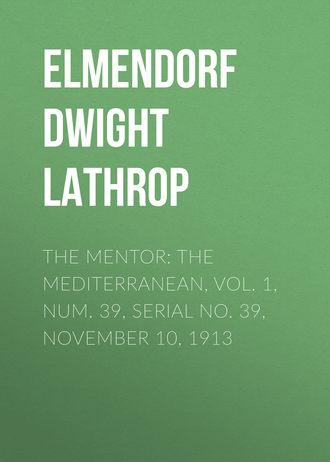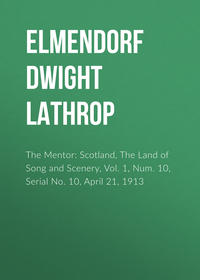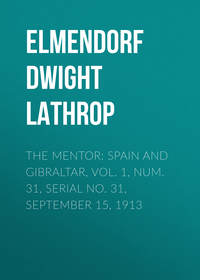
The Mentor: The Mediterranean, Vol. 1, Num. 39, Serial No. 39, November 10, 1913
Olives, with their grotesque and gnarled stems, are grown on great plantations in the Riviera. The warm climate produces luxuriant growths of figs, vines, citrons, oranges, oleanders, myrtles, and aloes. Bright green pine forests meet the eye, and even palms are seen occasionally.
Thousands of visitors spend the winter in the chain of towns and villages that stretches from one end of the Riviera to the other, – Nice; Monte Carlo in Monaco, the little independent principality; Mentone, the last town in the French Riviera; Bordighera; Pegli; Nervi; Spezia; and many others. In summer the Italians visit these resorts for sea bathing.
The only drawback to the Riviera is its liability to earthquakes, of which there were four in the last century alone.
A railway runs close along the shore all through the Riviera. The distance from Nice to Genoa is 116 miles, and from Genoa to Spezia 56 miles. In the latter stretch the railroad burrows through the many projecting headlands by means of more than 80 tunnels.
The poets Lord Byron and Shelley both lived and wrote on the shores of the Gulf of Spezia, and Charles Dickens, the great English novelist, wrote his well known story, “The Chimes,” at Genoa.
MONTE CARLO, MONACO
It is a curious thing that the smallest country in Europe is also one of the most visited. This is the little independent principality of Monaco. Monaco is only about eight square miles in area; and it is two and a quarter miles long. The population of the entire principality is only 19,000.
Monaco – the city of Monte Carlo in particular – is so greatly visited for two reasons, – its charming climate and situation, and its gaming tables. It is an excellent health resort, but is world famous as a gambling place. It was in 1861 that a man named François Blanc obtained a gambling concession in Monaco for fifty years from Charles III. A stock company later got hold of this concession, and in 1898 it was extended to 1947, in return for a payment to the prince of $2,000,000 in 1899 and another payment of $3,000,000 in 1913. In addition to this Monaco obtains from the company an annual tribute of $350,000, increasing to $400,000 in 1917, $450,000 in 1927, and $500,000 in 1937. These great tributes make it possible for the inhabitants of Monaco to be entirely exempt from taxation.
In the principality of Monaco there are three cities, – Monaco the capital, Condamine, and Monte Carlo. At one time the towns of Mentone and Roquebrune belonged to Monaco; but they were ceded to France in 1861 for $800,000. The city of Monaco occupies the level summit of a rocky headland, rising about 200 feet from the shore. Here the prince has his palace.
Monte Carlo lies to the north of the Bay of Monaco, where are gathered the various buildings of the Casino of Monte Carlo, with the beautiful gardens, and many villas and hotels.
The history of this little principality is an interesting one. It seems that long ago a temple of Heracles was built on the Monaco headland by the Phoenicians. The same god was worshiped there by the Greeks at a later date, and they gave the place its name. The Grimaldis, the present ruling family of Monaco, became associated with the place in the tenth century; but they did not come into permanent possession until much later.
Monaco in the fourteenth century was notorious for its piracies, and the right to exact toll from vessels passing the port continued to be exercised until the end of the eighteenth century.
For many years Monaco was an ally of France; but in 1525 it came under the protection of Spain. Then in 1641 Honoré II threw off the Spanish yoke and made himself an ally of France. The National Convention annexed the principality to France in 1793; but by the Treaty of Paris in 1814 it was restored to the Grimaldis. Finally in 1860 Monaco passed again under French protection.
The present ruler of Monaco, Prince Albert, was born in 1848 and succeeded his father, Prince Charles III, in 1889. The prince is absolute ruler, as there is no parliament in the principality. He appoints a small council to advise him on matters of state. He also has power to appoint the mayors and other municipal authorities.
NICE, FRANCE
The Massilians founded Nice 2,500 years ago. Its situation soon made it one of the busiest trading stations on the Ligurian coast. But in those days the price of prosperity was continual warfare. The Saracens descended on Nice in 729; and though at that time they were repulsed, in the next century they captured the city and burned it.
All through the Middle Ages, Nice had its share in the wars and disasters of Italy. It had to fight both Genoa and France, and on the sea its merchantmen were attacked by Barbary pirates. Finally in 1388 it placed itself under the protection of the counts of Savoy. In this way it was protected on land and could devote its strength to taking care of the pirates.
But bad fortune seemed to hover over the city. Invading armies devastated the land, and then pestilence and famine raged for several years. In 1543 Nice was attacked by the united forces of Francis I and Barbarossa. After a brave resistance the city was compelled to surrender, and was pillaged by the conquerors.
Then followed many years of alternate war and peace; until finally Nice was captured in 1792 by the armies of the French republic. It continued to be a part of France till 1814; but at that time it reverted to Sardinia. Then, in 1860, by a treaty between the Sardinian king and Napoleon III, it was again transferred to France, in whose possession it is today.
The city of Nice is a great winter resort for invalids and others from all parts of Europe. It is situated on the Mediterranean 100 miles east of Marseilles. A steep limestone hill, 308 feet in height, running back for some distance from the shore, is the historical nucleus of the town. It used to be crowned by a castle, which, previous to its destruction by the Duke of Berwick in 1706, was one of the strongest fortresses on the coast. Now it is a public pleasure ground.
Nice is a great commercial town. Grapes, olives, oranges, and mulberries are grown profusely, and in the city there are perfumery factories, oilworks, furniture factories, confectionery works, a national tobacco factory, and many others.
For the comfort and entertainment of visitors every provision is made. Autumn is the best season. Nice is at its liveliest during the carnival festivities. In these carnivals battles are waged with sweetmeats and flowers.
GENOA, ITALY
“Seas without fish, mountains without trees, men without honesty, women without modesty,” – that was what her enemies said about the republic of Genoa in olden times. And historians seem to agree that the character of the Genoese in those days was not of the best. All their energy was concentrated on commerce and the pursuit of money. They took no interest in art nor in any of the intellectual development of Italy during the Middle Ages. But these bad traits of the Genoese have all disappeared.
The city of Genoa now has 275,000 inhabitants, and is the seat of a university and an archbishop. It is the headquarters of the fourth Italian army corps, and is a strong fortress, as well as being the chief commercial town in Italy.
Genoa, with its many beautiful palaces, rising above the sea in a wide half-circle, is called “La Superba” (the superb). The old town is a network of narrow and steep streets, lined with many-storied buildings; but the newer part of the city has broad and straight thoroughfares.
In the seventeenth century the Genoese built as a protection against their enemies a rampart over nine miles long. They also erected on the heights around the town ten detached forts.
From the earliest times Genoa has been famous as a seaport. Today it still possesses its great mercantile supremacy, and in addition is an important emigration harbor. Far back in 400 B. C. its trade with the Greeks, Etruscans, and Celts was large, and as time went on it increased greatly.
In the Middle Ages the little rival Italian states were constantly at war with one another. Genoa had a war with Pisa, and in 1284 shattered the power of that city forever in a terrible naval battle at Meloria. Then came the struggle with Venice which ended in the defeat of Genoa at the battle of Chioggia in 1380.
The city of Genoa was also filled with internal political strife. Two or three different factions were continually fighting with one another, and this finally led to Genoa’s being always under the rule of some foreign prince. Finally in 1797 the aristocratic government of Genoa was superseded by the democratic Ligurian Republic, established by Napoleon, and in 1805 Liguria was formally annexed to the empire of France. Ten years later it was annexed to the kingdom of Sardinia.
Giuseppe Mazzini, the patriotic writer, was born at Genoa in 1805, and Garibaldi, the great Italian patriot and leader, with whom he worked, though born at Nice in 1807, was the son of a Genoese of Chiavari.
NAPLES, ITALY
Naples, the most important seaport in Italy, is also its largest city. In addition to this it is one of the most beautifully situated cities in the world.
The ancient Greeks founded Naples away back in olden times. They came from Cumæ and founded a city which they named Parthenope. Afterward this was divided into Palacopolis, the “old town,” and Neapolis, the “new town.” It was from the second that Naples got its name.
Later many other nations came into possession of the city, – Ostrogoths, Byzantines, and Normans. At one time Charles of Anjou made Naples his capital. Ferdinand I of Aragon, the Spanish viceroy, Don Pedro de Toledo, and the Bourbon Charles III all extended the city. Finally in 1860 the kingdom of which Naples was the capital was united to the kingdom of Italy.
Naples has not so many historic and artistic monuments as other Italian cities; but in the museum are preserved valuable treasures from Pompeii and Herculaneum, the old Roman cities that were destroyed by Vesuvius, and only within recent years have been excavated.
The best view of Naples may be had from the Bay of Naples. The city is built at the base and on the slopes of a range of volcanic hills, and rises from the sea like an amphitheater. The Castle of St. Elmo occupies a hill, from which a transverse ridge runs south to form the promontory of Pizzofalcone and divides the city into two natural crescents. The western part, the Chiara ward, is a long, narrow strip between the sea and Vomero Hill. This is the fashionable quarter. To the east lie the oldest and busiest quarters, of which the long Via Roma is the main street.
One cannot speak about Naples without mentioning Vesuvius. As one writer said, “Mount Vesuvius is to the Neapolitan bay what Fujiyama is to many a landscape of Japan, – the lofty background of the picture, and the grand presiding genius of the place. By day it proudly waves its plume of smoke, by night its torch of fire, as if it claimed to be the champion of destruction.”
A cable railway ascends Vesuvius now, and for many years the mountain has been quiet. But it is only slumbering. Some day it will break loose again and pour forth its streams of redhot lava, its agents of destruction.







